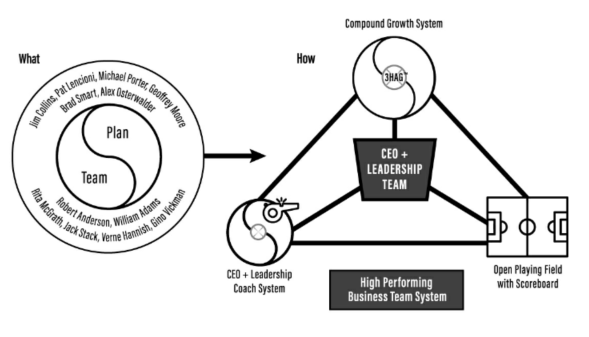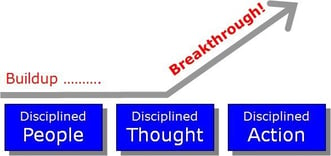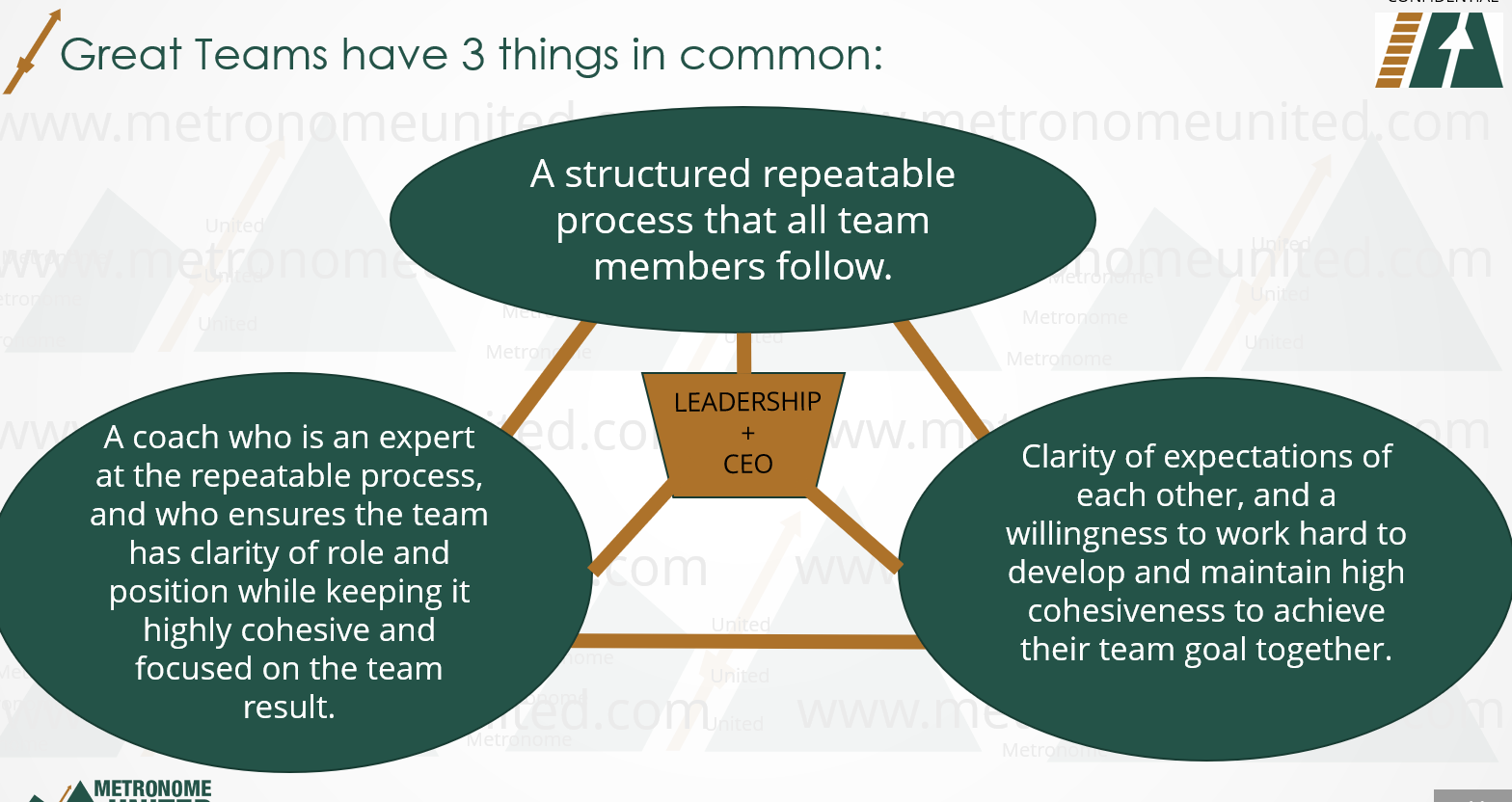-1.png?width=376&name=1%25%20Plan%20=%2099%25%20Behavior%201%25%20Plan%20=99%25%20How%20(Reality)-1.png) Growth is never a straight line to your BIG HAIRY AUDACIOUS GOAL or your 3HAG. It looks more like this picture Shannon Byrne Susko shared two weeks ago at our Metronomics Coaches Conference in San Diego.
Growth is never a straight line to your BIG HAIRY AUDACIOUS GOAL or your 3HAG. It looks more like this picture Shannon Byrne Susko shared two weeks ago at our Metronomics Coaches Conference in San Diego.
Business leaders most often overlook the ingredients fueling growth. Your businesses’ soft-edge systems (Culture, Cohesiveness, Human) require relentless focus. Most business leaders focus on the hard edge (Strategy, Cash, Execution) first.
Sustained growth requires these six systems are balanced. You may have heard, Culture Eats Strategy for Lunch.
Shannon shared, no matter the strength of your strategy, execution, and your cash position, without these three systems: Culture, Cohesiveness, and Human Systems, you will not be able to sustain success.
Whack A Mole
How do you get out of the Whack a Mole game?
Growth is often more like a game of Whack a Mole, where you’re moving from one fire to the next, putting them out, only to have another issue arise which requires your attention.
Soft-Edge Systems - Cultural System-1.png?width=576&name=Metronomics%20(Hard%20Edge%20-%20Soft%20Edge)-1.png)
The Cultural System ensures your culture is clear and known. Create a strong belief in your Core Purpose, team behavioral values (Core Values), and a long-term 10- to 30-year goal (BHAG) for your organization. It’s foundational for all high-performing teams.
Thought leaders like Jim Collins and Pat Lencioni use their principles to create a daily, repeatable behavioral system to ensure a company’s culture is not static. It’s not just on a wall somewhere. It pulses within your organization every day, starting with the CEO.
Cohesive System
Having a cohesive team while growing a company is challenging. It requires dedicated time, discipline, and focus. When your Cohesive System is effective, every day you progress and develop further as a highly cohesive team. Your team’s daily behavior affects your organization’s level of cohesiveness.
 The Cohesive System needs to be highly interconnected with the Cultural System to ensure team cohesiveness progresses and evolves every day in an organization.
The Cohesive System needs to be highly interconnected with the Cultural System to ensure team cohesiveness progresses and evolves every day in an organization.
Pat Lencioni’s The Five Dysfunctions of a Team framework is a tool I frequently utilize to grow cohesiveness.
I’ve worked with Pat’s framework to see amazing progress, incorporating these principles into daily and weekly meetings (Good News), building team trust, healthy team conflict, team commitment, and team accountability, to focus on team results.
Winning teams are highly cohesive and work at this every day!
Human System
Shannon developed the Human System in her first company. Each team member is supported with the same repeatable process, from recruiting to hiring, training, and onboarding, clarity of their functional role’s Scorecard, to coaching, feedback, and opportunity for growth and rewards.
 The Human System is founded upon A-Players who want to be coached and given the opportunity to grow. A-Players ooze the company’s Core Values and consistently exceed performance expectations; they’re attracted to being measured and held accountable for the position they volunteered to own on behalf of the team.
The Human System is founded upon A-Players who want to be coached and given the opportunity to grow. A-Players ooze the company’s Core Values and consistently exceed performance expectations; they’re attracted to being measured and held accountable for the position they volunteered to own on behalf of the team.
The Human System is inspired by Brad Smart’s Topgrading, which ensures you hire A-Players 9 out of 10 times by using a Scorecard to attract top talent who want to understand what is expected of them by metrics and clear accountabilities.
Once you have a team of A-Players, you must have a practical, efficient, repeatable system to support them. They want to be coached, kept, and grown into the next opportunity.
The Human System is highly dependent on the Cultural System, as all team members must behave according to the Core Values, ensuring the culture remains strong. A critical role of the Human System is to ensure all the functional roles of the “team required to win” are consistently filled with A-Players.
 A-Players attract A-players. These team members develop into a highly cohesive team.
A-Players attract A-players. These team members develop into a highly cohesive team.
The Human System is also connected to the hard-edge systems, ensuring the organization is functionally designed to align with the execution growth for current and future growth.
Without a Human System giving clarity of expectations to every team member, connected to the company goals, you will lose team members. And without the Cultural System, the foundation, the team will not reach its true potential and either stop growing or fall apart.
These 3 systems are present in every company. It’s up to you as the leader to be aware and have the discipline to implement and grow them. These systems work intensively together and with the hard-edge systems. Ironically, the soft-edge systems provide a clear and solid structure for all teams to achieve their goals.
To create an environment where everyone is inspired to give their best, contact Positioning Systems today to schedule a free exploratory meeting.
Growth demands Strategic Discipline.
 When you think of great teams, what’s the glue holding them together? What do they have in common? Next blog we’ll explore the 3 things all great teams have in common.
When you think of great teams, what’s the glue holding them together? What do they have in common? Next blog we’ll explore the 3 things all great teams have in common.
Building an enduring great organization requires disciplined people, disciplined thought, disciplined action, superior results, producing a distinctive impact on the world.
Discipline sustains momentum, over a long period of time, laying the foundations for lasting endurance.
 A winning habit starts with 3 Strategic Disciplines: Priority, Metrics, and Meeting Rhythms. Forecasting, accountability, individual, and team performance improve dramatically.
A winning habit starts with 3 Strategic Disciplines: Priority, Metrics, and Meeting Rhythms. Forecasting, accountability, individual, and team performance improve dramatically.
Meeting Rhythms achieve a disciplined focus on performance metrics to drive growth.
Let Positioning Systems help your business achieve these outcomes on the Four most Important Decisions your business faces:
|
DECISION |
RESULT/OUTCOME |
|
PEOPLE |
|
|
STRATEGY |
|
|
EXECUTION |
|
|
CASH |
|
Positioning Systems helps mid-sized ($5M - $250M+) businesses Scale-UP. We align your business to focus on Your One Thing! Contact dwick@positioningsystems.com to Scale Up your business! Take our Four Decisions Needs Assessment to discover how your business measures against other Scaled Up companies. We’ll contact you.
NEXT BLOG – All Great Teams Have 3 Things in Common






.jpeg?width=150&height=135&name=Hand%20with%20marker%20writing%20the%20question%20Whats%20Next_%20(1).jpeg)

